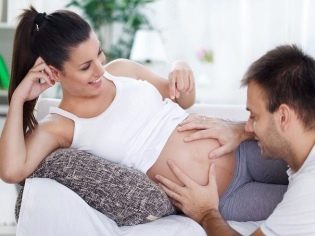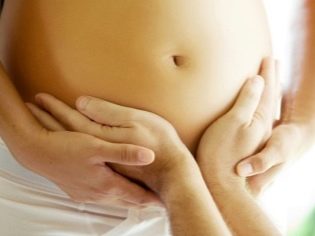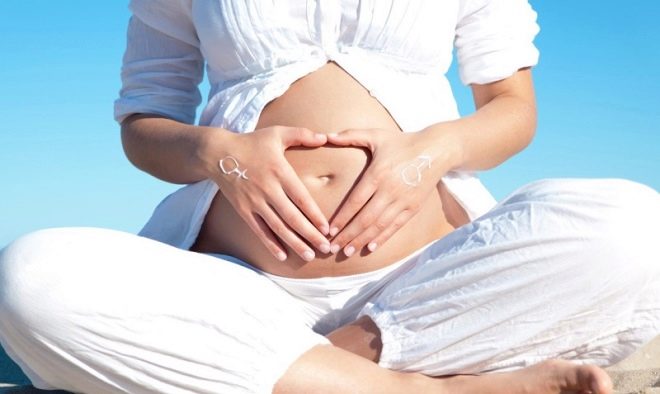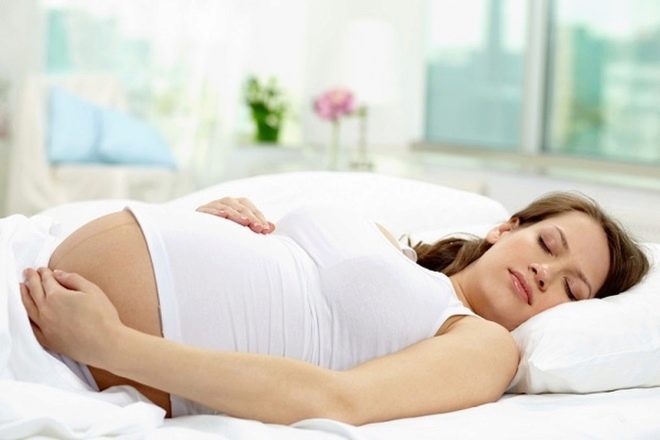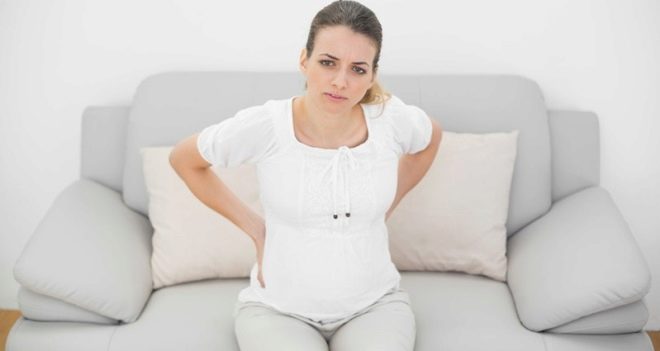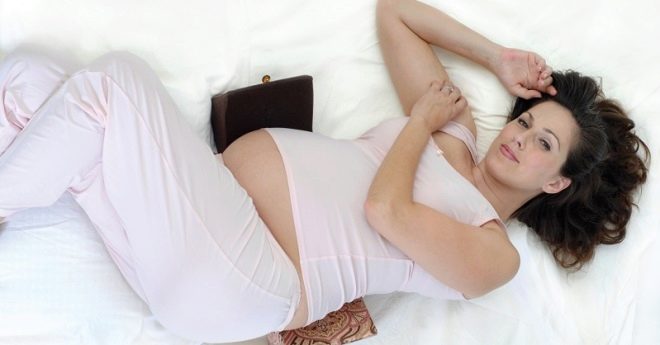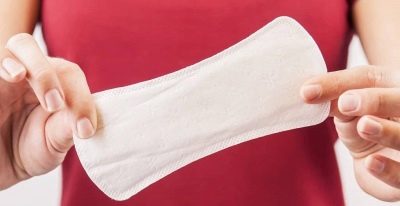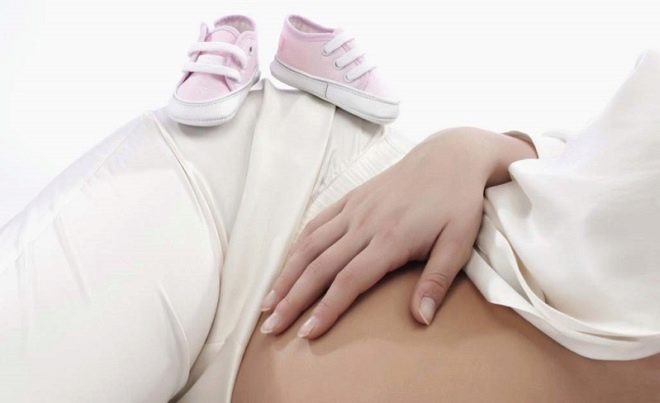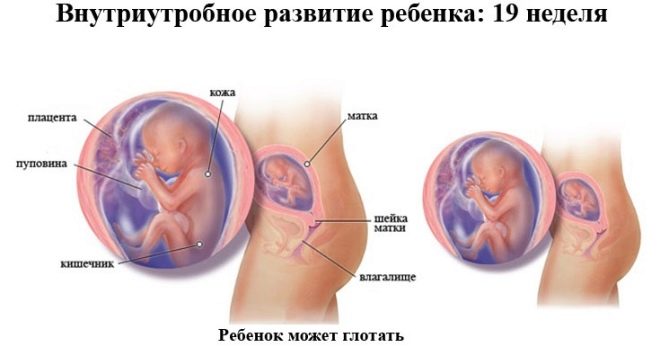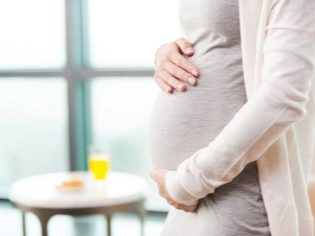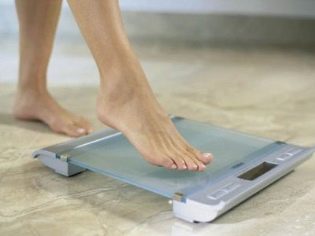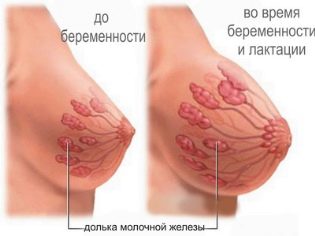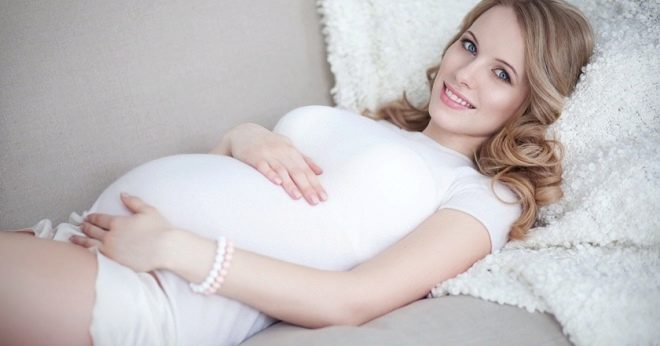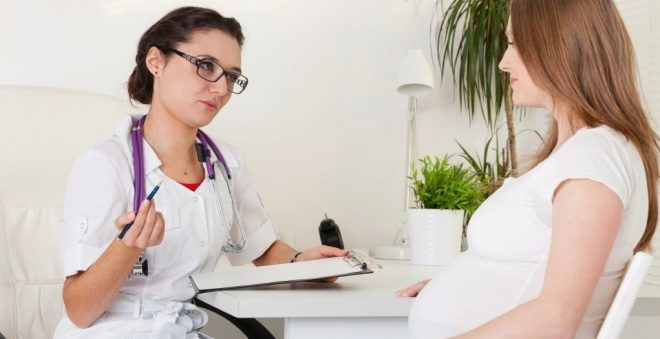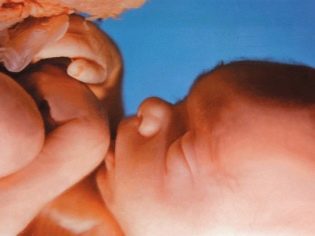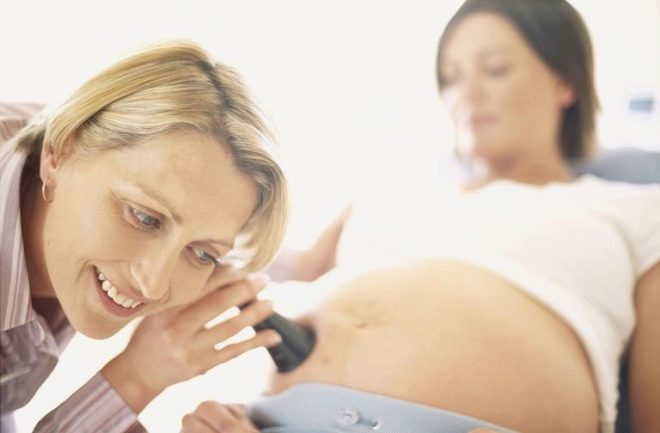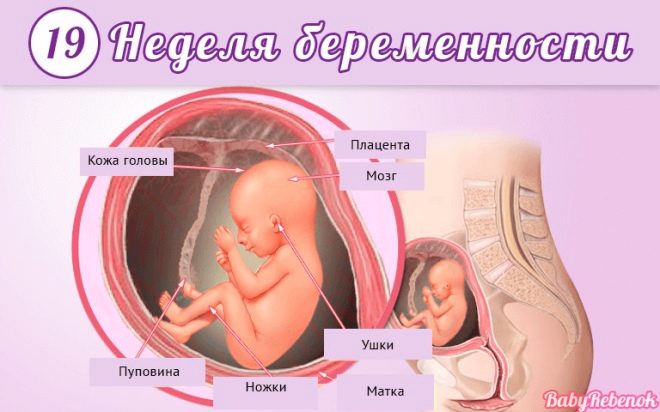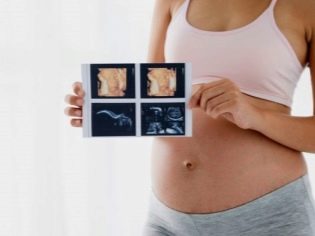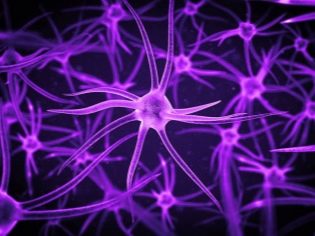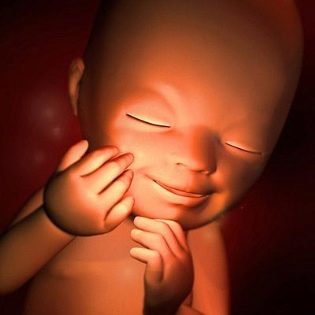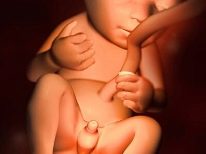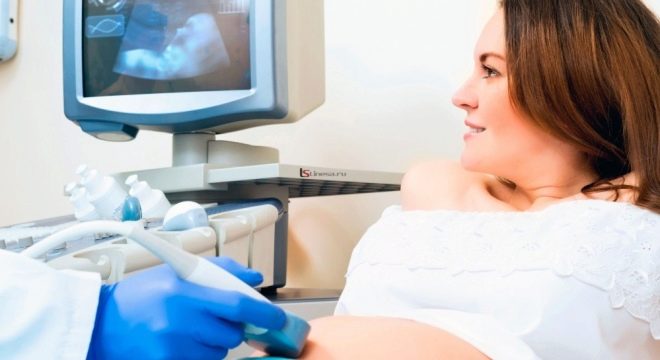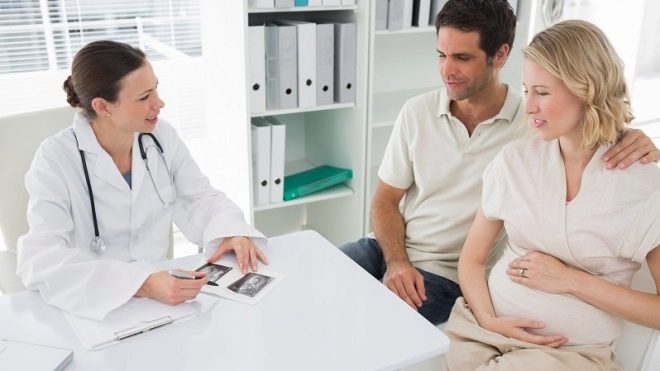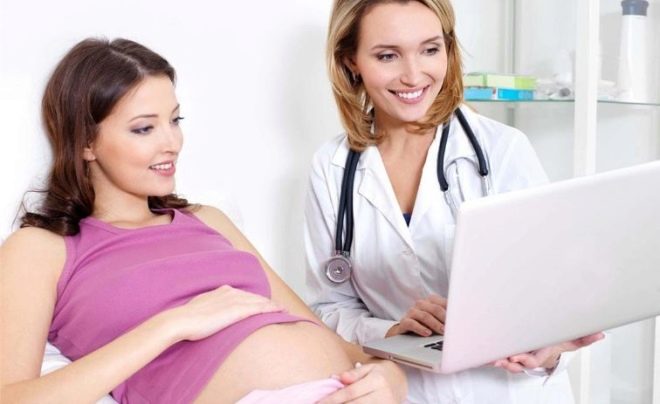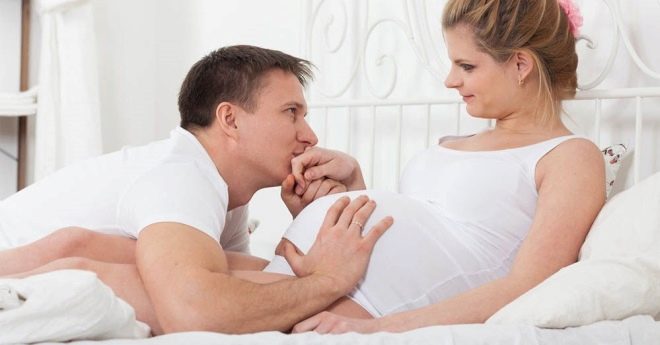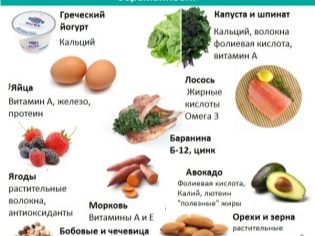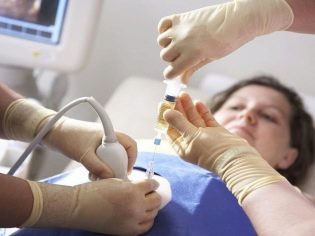19 week of pregnancy: what happens to the fetus and the expectant mother?
The middle of pregnancy is approaching, a woman can already safely assert that almost half of this long and interesting journey has been successfully completed. Began 19 week of pregnancy. This is quite an interesting and intense week, which may be remembered for a lifetime, because right now the contact between mother and baby is getting better - now they can feel each other. That still occurs on the given term, we will tell in more detail.
How many months is it
According to the usual calendar calculation is the middle of the fifth month. But according to obstetric standards, pregnancy is considered months not calendar, but lunar, in each of them exactly 28 days. The first obstetric week is already taking place when the baby is not yet present and the mother’s body is still preparing for ovulation and the subsequent fertilization of the released egg. When conception takes place, the third obstetric week will begin. The 19th week of pregnancy is the end of the fifth obstetric month, only a week and six days separate a woman from the “equator” of pregnancy - her middle.
If the woman is on the nineteenth week, it means that since the moment of conception 17 week has gone and 15 weeks have passed since the day of the delay of menstruation, which never “came” to the great joy of all households.
Now the woman is in the second trimester. Her gestation allows her to enjoy her position without experiencing heaviness or fatigue. All these unpleasant "satellites" will come later.
Feelings of the future mother
Before going on maternity leave for a long time, and now the daily life of a woman is not much different from the previous one: she still goes to work, study, does usual household chores, meets with friends.
The physical condition allows her to do it completely, because while the most calm and easy period of pregnancy is going on. However, in the outlook of a pregnant woman there have already been big changes - the understanding that another person will soon be born, for whom she is responsible, makes a woman more thoughtful, measured, serious. At week 19, the sensations can be very different, consider only some of them.
Stirrings
Future mothers are waiting for this moment as a real miracle. This week, the movement of the baby is already felt by all the women whose pregnancy is not the first, but the second or the third. Small thrusts are clearly felt, and women who are expecting twins or triplets. Waiting can only be those who bear the firstborn. The lack of movement should not frighten such a pregnant woman; normally, during the first pregnancy, they begin to be felt about 20 weeks.
In women, the question often arises as to why one is already perturbed, while another is having “silence” at the same time in the tummy. Answer it is definitely quite difficult, the movements are very individual. When they begin, it depends not only and not so much on the duration of pregnancy, but on the body of the pregnant woman, her sensitivity, the place of attachment of the placenta.
If the “baby seat” is located on the front wall, the woman will feel a stir a little later than a pregnant woman with a placenta on the back wall of the uterus.
Women who lead a more active lifestyle, move a lot, work, study, and later feel a stir, because during the day they have no time to focus on sensations in the stomach. And ladies who can afford to relax, rest, lie down for a day usually declare the appearance of new sensations earlier.
Some pregnant women, worried about the lack of movement, do not realize that the movement in fact already exists. Recognizing the first barely perceptible movements of the crumbs is not easy, especially if the pregnancy is the first.
Often, the future mother perceives them for the fermentation of gases or intestinal motility, and only when the baby grows up a little, increases in size, do they begin to understand that these were not gases at all. Usually such future moms find it difficult to accurately answer the question of their treating doctor about the date of the first movements.
Belly growth
At 19 weeks there are practically no pregnant women who would not have a growing belly. Even fat women, whose roundness begins to visualize later, now walk with a prominent tum. Regular clothing has become uncomfortable, now women are trying to change their wardrobe for more spacious things that do not hold down movements.
By the asymmetry of the abdomen in a supine position, a woman can already guess in which part of the abdominal cavity the baby is currently located.
The tummy resembling a ball is an object of increased attention from others. And there are always those who want to touch him. It is clear that this gives unpleasant feelings to expectant mothers.
You should not be ashamed to immediately designate your position in dealing with such people - only a categorical ban on strangers touching their stomachs can stop these attempts and return to the expectant mother emotional balance.
Now the grown uterus makes it impossible to lie on the stomach, it is also unpleasant to lie on the back, because the uterus squeezes the vena cava, which can cause a woman to feel dizzy. At week 19, you can wear a special antenatal bandage, which will ease the load on your back, legs and lower back.
Appetite and sleep
Women who are in the 19th week of pregnancy usually do not complain about the lack of appetite. I want to eat, and almost always. In such conditions it is important not to lose vigilance and not to “eat” extra pounds. It is important to control both the quantity and quality of food, as well as to avoid foods that are undesirable during pregnancy.
Sleep in general can be disturbed. But not because of hormones, as it was in the first trimester of pregnancy, but because of physical inconvenience - a woman constantly has to choose a comfortable position for rest. The choice is now small - only the right and left sides, at the time of the coup, spontaneous awakenings are possible.
To improve sleep, you can use special pillows for pregnant women, which give support to the stomach and upper leg. If there is no such pillow, you can replace it with three small pads that are placed under the abdomen, knee of the upper leg and under the pelvis (if necessary).
Mood and Emotions
A woman in the 19th week of pregnancy is a popular image in anecdotes, because of the forgetfulness and absent-mindedness of future mothers in this period, popular rumor adds legends. They are somewhat exaggerating the scale of what is happening, but on the whole it is noticed correctly - the woman now really is in a certain euphoria.
Its inhibition is due to the effect of hormones on the brain and nervous system - with the help of such a protective mechanism, the body reduces the load on the psyche and emotional sphere of the future mother, so that her experiences and strong emotions do not harm the developing baby.
In general, the pregnant woman becomes calmer, more peaceful.Now there are no strong worries about possible threats and risks. If the movements are already felt, then it becomes easier for the mother to communicate with her baby, she becomes more sentimental and sensitive.
A woman at this time usually doesn’t need much physical help, but she’s in urgent need of moral support, love and understanding at any stage of pregnancy.
Pains
At week 19, some women begin to feel that their pubic bone hurts when they change their body position. Pelvic bones soften, begin to disperse - so the body gradually begins to prepare for the upcoming delivery. If the pain is not strong, do not interfere with walking, sitting, then there is nothing terrible in this phenomenon. If the pubic bone is very worried, you should tell the doctor about it: perhaps the symphysitis begins.
Most often at the current time women complain that back and loin are aching. Such pains, if they do not occur abruptly, intensely, cramping, and are episodic, unexpressed, are quite natural - the growing uterus causes stretching and thickening of the ligaments. This is associated with tingling in the uterus, and small "lumbago" in the abdomen. Pulls the lower back and because of changes in the center of gravity, as well as due to the increased weight.
Head on week 19 rarely hurts. At the very beginning of pregnancy, hormone progesterone caused headaches, which produced a lot. Now headaches that last a long time and happen often can be more dangerous symptoms: high blood pressure, problems with the vessels are just some of the possible causes. Therefore, be sure to consult with your doctor.
Allotment
The discharge from the current week should be monitored constantly. This good habit in the third trimester will serve well. Panty liners will help the woman accurately identify any changes. Normally, discharge at week 19 becomes slightly more than before. But their texture, color and smell should not change.
Norm is a light, white, slightly yellowish discharge, odorless or with a faint sour odor. If the color of the vaginal secretion has changed, an unpleasant smell has appeared, it is necessary to visit the doctor without waiting for the date of the planned reception.
Blood discharge, pink, brown, both abundant and scanty, may be a sign of a beginning miscarriage. Brown weak "daub", especially after sex, may indicate that the woman has cervical erosion.
Dark gray, brown, green discharge is a sign of bacterial infection of the genital tract. Usually such secretions have an unpleasant smell, resembling a fishy one, and are also accompanied by itching or frequent painful urination.
White discharge on the background of itching, resembling cottage cheese in consistency, is a sign of thrush. This ailment often accompanies a woman throughout pregnancy, occasionally claiming to be exacerbated.
Watery discharge, reminiscent of the effects of urinary incontinence, may indicate leakage or discharge of amniotic fluid. If such discharge occurs, immediately call an ambulance.
It is not necessary for a woman to know all the features of a vaginal secretion, it is enough just to follow the rules of hygiene and always inspect your gasket daily before changing it.
Toxicosis
Toxicosis 19 week is not peculiar. However, we are talking only about toxicosis already familiar to women - with nausea and intolerance to odors and certain foods. It is now that another toxicosis can begin, a late one, which in medicine is called gestosis. Recognizing it is much more difficult.
Excess weight gain, if a woman tries to eat properly and follows all recommendations, can be a sign of internal edema - dangerous dropsy of pregnant women. Visible swelling can now appear on the face, on the arms, on the legs.The first alarming symptoms are difficulties with removing the rings from the fingers, as well as the characteristic prints from the rezinochki socks on the ankles.
If at the 19th week such signs appeared, the woman should be sure to inform her doctor about it. Complicated in this way, pregnancy can result in premature birth, placental abruption, fetal death of the baby, fetal hypoxia, complications of childbirth. A pregnant woman with preeclampsia needs special medical supervision.
Changes in the body
At week 19, a woman may for the first time feel tingles in the navel. This is a completely normal phenomenon associated with stretching the skin of the abdomen. Soon this unpleasant feeling will pass. Among other physiological changes are the following.
Uterus size
The uterus has increased markedly. Now the line of its bottom (upper part) is only a centimeter below the navel. The height of the bottom of the uterus now ranges from 17 to 21 centimeters, most often - 18-19 centimeters. The uterus is located in the abdominal cavity, gradually "pushing" the internal organs.
The length of the cervix - 40-45 mm, a shorter neck can be a serious complication of pregnancy. Shortening her on this period is regarded as isthmic-cervical insufficiency, which represents a threat of miscarriage of the child.
For the entire period of childbearing, the uterus of a woman increases approximately 500 times, and its growth is still ahead. From this week, the measurement of the height of standing of the bottom of the uterus will be carried out at each scheduled reception at the obstetrician-gynecologist. The obtained data of the VSMD are recorded in the exchange card of the future mother.
Weight gain
By this week, all women, without exception, state that they have significantly recovered, gained weight. But the increase itself will be different. The increase in body weight now is not only a consequence of the future mom's good appetite, but also a physiologically determined situation - under the action of progesterone, during the first trimester, fat reserves were deposited, and now the amount of blood has increased, the placenta is developing.
How much a woman adds to the 19th week depends on her initial weight. If she was thin before birth, then now she will see + 5.6 kilograms on the scales normally. Women with normal weight or slight overweight before pregnancy should now add no more than 4.9 kilograms. Future moms who have been diagnosed with obesity, now should not add more than 2.6 pounds.
If the increase significantly exceeds these norms, the doctor will definitely prescribe additional tests to find out if the woman has internal edema or preeclampsia. There will also be assigned a universal diet for pregnant women, which will help to bring the weight in accordance with the rules.
It is desirable to weigh a woman not only at the reception once a month, but every week at home. To do this, it is best to carry out the weighing on the same day in the morning after using the toilet: the results will be more reliable.
Chest
The mammary glands in many pregnant women have increased by more than two sizes. Now they do not hurt as much as it did in the first third of the pregnancy, but the nipples continue to remain more dense and sensitive than before the pregnancy. Near-sparger circles could darken, small hillocks, so-called Montgomery nodules, could appear on the nipples and around them.
This week, a woman may begin to be disturbed by itching in the lower part of the mammary glands and on the sides - this is a stretching of the skin. If you do not take the right measures now, ugly and difficult to remove stretch marks on your chest may remain. To prevent their occurrence, now a woman can start using softening moisturizing hypoallergenic creams, as well as start wearing the “right” bra, reliably supporting breasts with locking cups and wide straps.
For many women who are carrying their second or third baby, thick white or yellowish colostrum is already released from the nipples. In primiparous women it may not yet be.
Hair and skin
The hair of a woman at the 19th week of pregnancy becomes thicker and silky. The skin of a woman acquires unprecedented sensitivity, which is why it is now not recommended to experiment with new cosmetics. It is better to refrain from excessive use of old proven means without urgent need. Contact allergy is one of the most common complaints among women who are at this time.
Pregnant now is not recommended to visit bathhouse, sauna, solarium. Any thermal effect on the skin in particular and on the entire body as a whole is dangerous.
If the middle of pregnancy falls on a hot summer, you should protect your skin from excessive exposure to sunlight, so as not to provoke excessive pigmentation. If the term falls on the height of winter, the skin should be protected from exposure to cold wind.
Dyspnea
At 18-19 obstetric week, a woman may begin to feel quite pronounced shortness of breath. Even small physical exertion, usual household chores, a short walk with quick steps can cause feelings of lack of air, dizziness. The causes of this phenomenon at this time two.
- Increased circulating bloodand, accordingly, the load on all organs, including the lungs of women, increased in frame proportions (by more than 40%).
- Development of shortness of breath contributes to growing uteruswhich already begins to "prop up" the diaphragm. If dyspnea hurts often, you should discuss this issue with your doctor, he can recommend breathing exercises and, if necessary, examine the respiratory system of a pregnant woman for possible pathologies. Infrequent attacks of dyspnea do not need treatment; a woman just needs to learn how to measure her strength, avoid physical overloads, try to walk slowly, measuredly.
Baby development
Intensive growth of the fetus is completed, now the crumb will grow more calmly and gain weight every day. At week 19, its dimensions are comparable to a very large potato tuber. The growth of the baby is 22-25 centimeters, and the weight is almost 300 grams.
For 17 embryonic weeks, the baby has gone through several stages of development - it was a set of cells, an embryo, now it is considered a fetus, there is a fetal fetal period.
Appearance
The skin of the baby gradually ceases to be wrinkled and red. This is due to the fact that the formation of subcutaneous fat has already begun, which gradually accumulates, smoothes the "wrinkles" and separates the thin layers of skin from the bloodstream of the network, because of which that red color was present.
Every day the crumb becomes more and more pretty, he begins to appear the first roundness. Subcutaneous fat is primarily deposited on the neck, in the area of the shoulder blades, on the chest and lower back. In the first days after the baby is born, this fat will help maintain body temperature, and will also be an important source of energy for the new man.
The thinness of your baby is still present, the arms and legs look very thin, the tummy is also far from the generally accepted notions about the appearance of the tops. But the head began to acquire normal proportions, gradually slowing in growth against the background of growing faster than other parts of the body.
At the beginning of pregnancy, the head of the embryo was the largest part of the body, now it is only about a third of the area of the body, and by the time of birth it will be only one fifth. The face of the baby is now unique. It does not look like other kids' attractive faces, because in it all the hereditary features now appear in all their glory - big nose or snub-nosed “button”, sponge “bow” or wide, eye shape, shape of chin, forehead height.
The baby's profile is clearly visible on the ultrasound, and observant future parents are already beginning to guess what the baby looks like.
The whole body of the crumbs is covered with thin blond hairs - lanugo. This is how the first hair follicles begin to function. These hairs - a temporary phenomenon, they will fall out closer to childbirth. Sometimes babies are born with lanugo that has not completely disappeared, and the fluffy hair disappears gradually over several weeks after birth. In addition to hair, baby skin is densely covered with cheese-like lubricant. This makes the skin more protected before exposure to the aquatic environment in which it is located.
Appearance crumbs formed to the smallest detail: there are cilia and eyebrows, tiny feet grow on the fingers and toes, there is a unique individual identification sign on the fingertips - a pattern that forms a fingerprint. The baby has joints, a rather mobile neck, all the ribs are formed, and the chest has acquired clear forms.
Internal organs
This labor "feat" in the current period of gestation makes a tiny heart - it pumps 23-24 liters of blood per day, completely covering the needs of the child's body for blood supply.
The baby's heartbeat is almost twice the frequency of his mother's heartbeat. The normal heart rate this week is 150-170 beats per minute. In the heart shaped all departments. Completed and the formation of all blood vessels.
The development of the digestive system continues. Now in the gut of the crumbs, the original cal meconium is deposited. In fact, meconium is a dead epithelial cells that the baby can swallow together with the amniotic fluid. The rich black-green color of meconium gives bile, which is produced by the gallbladder and partially enters the intestine.
Functions of the stomach, pancreas. The liver successfully combines two “works” - it participates in the process of blood formation and helps the digestive organs.
The lungs and bronchi of the crumbs are formed, but not completely. In the lungs, surfactant accumulation has not yet begun. Without this essential substance, the baby's alveoli will stick together while trying to breathe, and it cannot survive. The required amount of surfactant is usually accumulated by the end of the second trimester. The kidneys are actively working, producing urine, the baby emptying the bladder about once an hour.
Despite the fact that all the organs are fully formed, the baby, who will be born on week 19, will not be able to survive on its own. Medicine is powerless in helping such crumbs, so the expectant mother needs to look after her health and avoid situations that are dangerous and risky for the baby's life.
Nervous system
It is the nervous system that is undergoing the most intense changes. Every minute more and more new neural connections are formed in it. The brain, in which gray matter is now actively growing, the so-called bark, has already begun to establish control over the movements of the crumbs.
Now the baby can consciously send the cam into her mouth, reach for the umbilical cord, try to grab her leg, and also knock on the wall of the uterus. It is these touches that the woman feels like movements.
Reflex skills are developed well enough: sucking and swallowing reflexes were formed among the first. The baby is able to grab, compress the cams, and also has a rudimentary instinct for self-preservation: when feeling threatened from outside (loud noises, abruptly changing the position of the pregnant woman’s body), the crumb is “scared” and tries to shrink more compactly.
With a random touch to the walls of the uterus with the legs, the baby briskly pushes away - this reflex will later help him to master vertical walking. The skin, thanks to a developed network of nerve endings, is very sensitive. Information from them already receives and "processes" the brain.
Sense organs
Baby from this week begins to hear.And this is the main event that radically changes the attitude for him. At week 19, the formation of the auditory ossicles is completed, the vibration of which allows the structures of the auditory analyzers to detect the difference in sounds.
Until that time, the baby had heard, but only the vibration that was created by my mother's voice, the loud sounds of the parents alarm clock, the barking of a dog next to the expectant mother. Now a completely new world of full-blown sounds opens up for him. He will gradually comprehend them.
Now he will begin to listen to what surrounds him: he is interested in the beat of his mother's heart, her breathing, the work of her intestines and the sound of blood flow. Almost immediately, he will catch the voice of his mother, because he already knows him on a vibrational level. Every day the range of perceived sound information will become wider, and the baby will gradually begin to pick up various sounds from the outside.
Now it is more important than ever to talk to a child, read fairy tales to him, sing songs. By the way, the lullabies that the mother will now hum to the baby will be recognized immediately after birth.
The baby will open its eyes in about 2 months. In the meantime, the retina has become more sensitive, which allows the crumbs to distinguish light from darkness through tightly covered eyelids. The eyes of the little ones began to make quick movements left and right. Proponents of physiology say that this is due to the development of the muscular system of the organs of vision, and supporters of metaphysics claim that the pussy has already begun to dream.
The tiny man in the womb has a well-developed tactile sensations, he distinguishes the nuances of the taste of amniotic fluid. If the mother eats a sweet, the baby will begin to swallow the amniotic fluid with great enthusiasm, if the mother’s menu has garlic or onions, the baby will wriggle hilarious grimaces of discontent, pucker when she swallows water. Even such small children love sweets.
Sex determination
External genitals are fully formed and no longer cause doubts. Boys look like boys and girls look like girls. Right now the most suitable moment has come for determining the sex of the baby on ultrasound. A little later, the child will be too large, he will take a compact pose, covering his intimate places with his hands and the umbilical cord. therefore the definition of sex in the third trimester is not considered accurate.
At the beginning of pregnancy, the genitals were almost identical, too small, and the probability of error was also high. Now the review is ideal in order to finally find out who to expect - a son or a daughter.
An important stage now begins in the boys' body - the testicles, which were formed and grew up in the abdominal cavity, begin to gradually descend, first into the small pelvis, and a little later - into the scrotum. In girls, the sex glands have long since taken their rightful place in the pelvis: the ovaries, the uterus, the tubes — everything is where it should be.
Sex hormones are produced so far only in the body of future men. Little girls are forced to content themselves with the concentration of maternal hormones that come to them with their mother's blood.
Your baby on ultrasound
Ultrasound examination this week visits the vast majority of pregnant women. It is considered mandatory, since this is the second prenatal screening study. Mom will be able to see and evaluate for herself what impressive results her baby has achieved.
The main size, which made it possible to draw conclusions about the growth rates of the crumbs in the first trimester - the coccyx-parietal - is no longer measured, because the little one no longer fits in the zone of visibility of the ultrasound scanner. KTR is not defined.
But the sizes of separate parts of the body are perfectly visible, by which doctors judge the proportionality of the baby’s body and its development. Such dimensions are called fetometric indicators.
Normally, for the 19th week such values are characteristic:
PDU, mm | LZR, mm | OG, mm | Coolant, mm | The length of the femur, mm | Shin bones, mm | Forearm bones, mm | Humerus, mm |
42-45 | 54-58 | 146-158 | 124-134 | 27-30 | 24-27 | 20-23 | 28-31 |
BPR is the transverse (bipariented) head size, and LZR is the frontal-occipital (longitudinal) head. Each separately and both together serve as the main marker for the compliance of the baby’s size with the period of gestation. The lengths of paired bones are also indicative of the duration of pregnancy and can tell a diagnostician about the development of a child. The thickness of the placenta is now in the range of 20-21 mm, the umbilical cord has a diameter of about 2 centimeters and three vessels in the cut.
Possible risks and hazards 19 weeks
The main danger of this week is reduced immunity. From the very first hours after the accomplished conception it is suppressed by the hormone progesterone. Such immunosuppression is necessary so that the immunity of the woman does not perceive the embryo as a foreign object and not deal with it.
By 18-19 weeks of pregnancy, immunity is suppressed to a critical point. There are practically no threats of miscarriage, non-developing pregnancy, but there is a high probability of getting an acute respiratory viral infection, flu, catching a cold, catching a sore throat or bronchitis.
The consequences of a cold will no longer be so devastating for a baby as they could be in the embryonic period of its development, because the crumb has grown strong, his own immunity has already begun to form.
Incorrect treatment carries a far greater threat. That is why a woman at the first signs of the disease: cough, runny nose, high fever should call a doctor and get competent advice on the treatment of a particular ailment.
Women from obstetric week 18-19 often complain of heartburn, diarrhea or constipation. Significant difficulties with digestion are possible due to mechanical compression of the abdominal organs by the growing uterus, as well as due to the violation by the woman of the principles of healthy and proper nutrition during pregnancy.
Colitis, an ulcer, and gastritis can aggravate even when such illnesses are in history, a woman has already had problems with the health of the digestive organs, because pregnancy itself increases the load on all organs.
Treatment during the second trimester is often carried out with antibiotics such as Flemoxin. The potential benefits of taking such funds at this time exceed the risks. Reduced immunity at week 19 can cause cystitis, pyelonephritis and other problems with the urinary system. A woman's body becomes vulnerable to viruses and bacteria.
With the appearance of characteristic symptoms - frequent urination, cramps, abdominal pain, lower back pain, the woman should immediately report this to your doctor and pass urine and blood tests.
Frequent constipation and a sedentary lifestyle can cause an unpleasant and very painful disease - hemorrhoids. They suffer about 40% of pregnant women at this time. This condition also requires medical consultation and prescription of drugs that, without harm to the health of the baby, will be able to save a woman from a delicate affliction.
In general, the expectant mother should be very attentive now to her state of health. Muscle walls of the uterus in the normal should remain relaxed, and the arrival of the uterus in the tone is also a reason for an unscheduled meeting with the doctor.
To determine the tone of the woman can have their own - the belly "koneet", the upper border of the uterus begins to clearly appear just below the navel. A pregnant woman at week 19 feels the uterus almost constantly, it is impossible to miss changes in her tone.
Analyzes and surveys
This week, future moms are undergoing second antenatal screening. A blood sample for analysis, which received the name of "triple test" by the 19th week is usually already passed. If this was not done 7-10 days ago, then the woman is often handed a referral to the laboratory right now.
In the blood of the future mother determine the concentration of the three components - hCG, free estriol and alpha-fetoprotein.Their increase or decrease in the relative norm may indirectly indicate defects in the neural tube of the fetus, the presence of chromosomal abnormalities in the baby — Down syndrome, Edwards syndrome, Turner, and a number of other gross pathologies.
Unlike the first trimester screening, second screening It does not necessarily take place on the same day: between a blood donation and a visit to an ultrasound examination room, it can take a week or more. But the data of the laboratory examination and the protocol of the ultrasound diagnostician are still evaluated by a special computer program as a whole.
In addition to screening studies, at week 19, the woman who is prescribed should have a urinalysis and complete blood count. Now is the time to check how the kidneys work, whether sugar in the urine and blood is elevated, and whether the woman has anemia. Low hemoglobin at this period is detected in approximately 20% of pregnant women.
Recommendations to the future mother
From compliance with the basic recommendations depends on how easy it will be further pregnancy. Ahead is her most difficult period, the third trimester. A woman needs to gain strength, prepare for the upcoming delivery in advance.
Do not forget about daily walks. They will help a woman to saturate her blood with oxygen, which means that the baby will get it more. Good to take oxygen cocktails.
Now it is important to keep track of your weight, it is advisable to keep a diary, where a woman will be able to record her feelings, weight, menu. This notebook will help your doctor to understand in more detail what is happening to the future mother and why.
Next, read the answers to the most pressing questions of this week of pregnancy.
Sex
If there are no contraindications, sex on week 19 is quite possible. Orgasm has a positive effect on the blood circulation of the uterus, on the mood and emotional state of the pregnant woman. She still does not feel clumsy, at week 19 her libido increases, her sexual sensations increase.
Spouses should not forget about safety rules: postures should now be chosen such that there is no deep penetration, so that there is no mechanical pressure on the woman’s tummy. For this reason, the riding position and the missionary position are no longer suitable.
From anal sex, from the use of sex toys and gel-lubricants is now better to give up. This can cause future harm to the mother's health. In general, the stomach is still not very restrictive and embarrassing spouses.
If, after sex, a woman notices an unusual discharge of a strange color or texture, she must consult with a doctor.
Nutrition
Nutrition of the future mother should be balanced, she should receive daily proteins, slow carbohydrates and fats in an amount that covers daily needs. Eating should be at least 5-6 times a day, it is better to reduce the volume of servings. "Measure" can be the hands of a pregnant woman - On a plate of a woman should be a portion, which is comparable in volume to the volume of the palms, folded "boat."
Now it is better to abandon fatty pork and lamb, from fat, oily fish. It is best to replace them with beef, rabbit meat, turkey meat and chicken. You should not eat sausage and sausages, smoked meats, spicy, salty and fried dishes. To the benefit of not going to a large amount of sugar and sparkling water.
Be sure to at this time in the menu should include raw vegetables and fruits: fiber helps to avoid constipation and hemorrhoids. For the prevention and treatment of anemia, it is recommended to eat foods with a high iron content - buckwheat, beef liver, blueberries and strawberries, dried mushrooms and fresh apples.
Dairy products, spinach and fresh greens, pistachios, peanuts, as well as some varieties of sea fish will help to avoid problems with hypocalcemia and provide the baby with the necessary amount of calcium, which he now needs for bone growth. Do not forget about the required amount of drinking water - per day her woman should drink about one and a half liters.
If there are swelling, the amount of water is discussed with the doctor.The amount of salt to all pregnant women, it is recommended to reduce to 5 grams per day.
Gymnastics
To do gymnastics for pregnant women need daily. A set of simple and simple exercises that do not require outstanding physical data from a woman will help prepare all muscle groups for the upcoming labor and facilitate the recovery process after them. Exercises associated with sharp corners of the body, bending should be avoided - dizziness and loss of consciousness may occur due to differences in blood pressure, which are characteristic of the current gestational age.
You can also begin to train your pelvic muscles with the help of a complex of Kegel exercises. This will help strengthen the walls of the vagina and pelvic ligaments before the upcoming birth, as well as significantly improve the quality of sex life of both partners.
Invasive diagnosis - is it necessary to do?
If the second screening shows alarming or questionable results, the woman is usually advised to visit the genetics and get directions for invasive diagnosis. Cordocentesis or amniocentesis are very informative methods in order to get an answer to the main question - is the baby healthy?
But they are deservedly considered quite traumatic and dangerous: puncture of the abdominal wall, by means of which an amniotic fluid or cord blood sample is taken by inserting a needle into the uterus, can cause fetal membranes to become infected, or the fetus will die.
In order not to risk, a woman can do a non-invasive test. Now NIPT is available in medical genetic centers, however, its cost is high - several tens of thousands of rubles. This is a completely safe technique. A woman takes blood from a vein, fetal blood cells are found in her, secrete DNA and conclude that the baby has developmental abnormalities. There is an alternative.
However, if NIPT shows that the baby is sick, you still have to do invasive material collection, as long as the DNA test for maternal blood is not accepted as a reason for terminating a pregnancy at a late term for medical reasons, if a woman is not ready for the birth of the “special” baby
Reviews future moms
According to the shape of their abdomen in the supine position, future mothers have already learned how to determine the location of the fetus in the uterus. At week 19, some describe that they were able to establish full contact with their crumbs. Putting a hand on her belly, mom can get an easy reciprocating pinotch from the inside. This makes pregnant women really excited. Those who do not feel anything but heartburn and constipation are very worried this week, but there is no reason for disappointment, just everything - its time.
Now, when the sex of the baby becomes known, many mothers begin to choose a name and slowly try to buy a dowry baby. There is nothing terrible in this, but it is better to dismiss all the bad omens.
Experienced mothers know for sure that purchases before birth are sheer torment for the future mother, purchases after birth are torment for the young father, because he will have to do this, and it’s not at all the fact that a man will buy everything that is necessary and suitable. Now is the ideal time for shopping: it’s still not hard, not burdensome, and it is quite possible to take advantage of it.
About what happens to the fetus and the future mother at the 19th week of pregnancy, see the following video.





